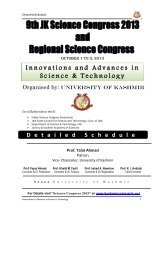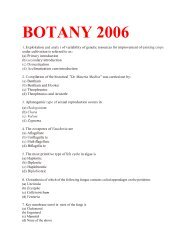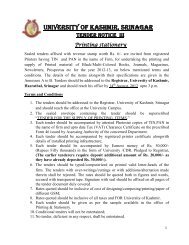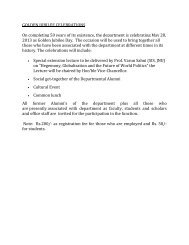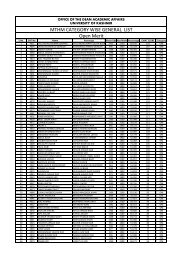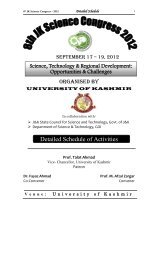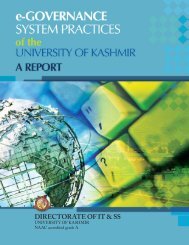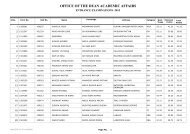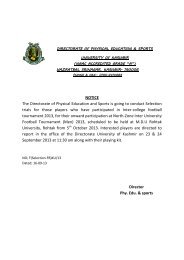indifference
MERC Times Issue Dated 30-05-2011 - University of Kashmir
MERC Times Issue Dated 30-05-2011 - University of Kashmir
- No tags were found...
You also want an ePaper? Increase the reach of your titles
YUMPU automatically turns print PDFs into web optimized ePapers that Google loves.
KU Releases<br />
Annual Report 2010-11<br />
2 5<br />
Crammed for space<br />
Vol: 4 | No.: 3 | May 30, 2011 Lab newspaper of Media Education Research Centre for private circulation only<br />
From fertile Dal to marshy Rakh<br />
Photo By : Tawseef Ahmad<br />
to them.”<br />
The residents also complain of water<br />
seeping into their homes during rains.<br />
This, they said, also hindered their plans<br />
of constructing a proper house.<br />
Rakh-e-Arth is a low lying area and<br />
though much of the project cost has been<br />
spent on filling of the land with hundreds<br />
of truckloads of soil, the threat of flooding<br />
persists.<br />
“Most people of our community<br />
didn’t come here because of this problem,”<br />
said Irshad.<br />
According to LAWDA VC, the irrigation<br />
department is working to solve the<br />
problem.<br />
The Rakh settlers say the government<br />
overlooked their livelihood needs.<br />
“We were dependent on agriculture,<br />
which is impossible to carry out in this<br />
area,” said Ali Muhammad.<br />
Continude on Page 3<br />
Mir Usman<br />
‘We were betrayed’<br />
Not far from Rakh-e-Arth is Boat Colony,<br />
another habitation created for families<br />
relocated from Chinar Bagh on the banks<br />
of Dal Lake’s main outflow channel, Chunt Kol.<br />
The locality in Bemina area used to be deserted<br />
before the present dwellers moved in 1990.<br />
Like the Rakh settlers, they also allege government<br />
apathy towards their needs. They accuse the<br />
authorities of reneging on their promises.<br />
“The government officials had promised<br />
to provide us living quarters, but instead we got<br />
dirt and filth,” said 62-year-old Abdul Rehman<br />
Dandroo, president of the local shopkeepers’ association,<br />
pointing to the dusty road.<br />
Before the settling at Boat Colony, the<br />
people from Chinar Bagh and other peripheries<br />
of Dal Lake lived in houseboats and shacks and<br />
therefore its name.<br />
Continude on Page 3<br />
Leaving behind their home and<br />
hearth in the interiors of Dal Lake,<br />
the Bala household shifted to Rakh-e-Arth<br />
despite widespread concerns<br />
over the marshy nature of land in this<br />
suburban neighbourhood, only to be let<br />
down by the government.<br />
Bashir Ahmad Bala, along with<br />
seven other farming families, moved to<br />
Rakh-e-Arth (Kashmiri for game-preserve)<br />
near Bemina 10 months back.<br />
The vast stretch of land, spanning over<br />
7,526 Kanals, has been earmarked for<br />
rehabilitation of people living in the<br />
interiors of Dal under Rs 402-crore<br />
project for conservation of the world<br />
famous lake, overseen by Lakes and<br />
Waterways Development Authority<br />
(LAWDA).<br />
Residing in temporary wooden<br />
shacks, the families allege official <strong>indifference</strong><br />
towards their needs.<br />
“We are not happy with the authorities.<br />
We were promised good accommodation,<br />
school and healthcare<br />
facilities but there are no such things<br />
present here,” said Bashir.<br />
“With no school nearby the future of<br />
our children is at stake.”<br />
The families spent the last winter<br />
in the shacks finding it hard to cope<br />
with the cold.<br />
“We are living in temporary shelters<br />
and have to bear the brunt of the weather,”<br />
said Irshad Ahmad, who resides next to<br />
Bashir.<br />
They also complain about lack of<br />
transport facility, having to travel about<br />
one kilometre to board public transport.<br />
When asked about the complaints,<br />
Vice Chairman LAWDA, Irfan Yasin<br />
said, “The developmental work in the<br />
area is taking place in a phased manner.<br />
All these facilities will be provided<br />
‘Freeze Frame’<br />
released<br />
Syeda Afshana’s anthology<br />
well received<br />
Mohammad Rafi Dar<br />
Freeze Frame: Glimpses from Kashmir,<br />
a book by Syeda Afshana was released<br />
at Ibn-I-Khaldun Auditorium of Allama<br />
Iqbal Library, Kashmir University on May 19.<br />
Speaking on the occasion, Vice Chancellor,<br />
Kashmir University, Prof Riyaz Punjabi<br />
appreciated the author.<br />
“The society which doesn’t tolerate<br />
dissent would decay but dissent should be<br />
constructive not destructive,” he said.<br />
Noted academician, Prof Aga Ashraf Ali<br />
praised the author for her “courage” to write<br />
on sensitive issues at such a young age.<br />
Continude on Page 3
MERCTIMES 2<br />
Srinagar: City of unplanned colonies<br />
Mohammad Rafi Dar<br />
It is summer and Farida Begum’s<br />
single-storey brick and mud house<br />
is surrounded by stagnant water.<br />
The only approach to this house is a<br />
temporary wooden bridge-like structure<br />
that passes through the marshy<br />
land. Welcome to Hamdania Colony in<br />
Srinagar.<br />
On the Srinagar-Muzaffarabad national<br />
highway, Begum’s house is not<br />
a solitary example. A large number of<br />
houses in the backside of this residential<br />
colony are inundated by water for<br />
most part of the year. Reason: a flood<br />
spill channel was turned into a housing<br />
colony more than two decades ago.<br />
“There is hardly any land available<br />
in Srinagar and its peripheries,” says<br />
Commissioner, Srinagar Municipal<br />
Corporation, Sheikh Mushtaq. “That is<br />
why people are constructing houses in<br />
these areas”.<br />
Urbanization, poverty and rural<br />
migration are generally attributed for<br />
the constructions in this low-lying area.<br />
People from various parts of the city<br />
and other districts of valley have shifted<br />
to this place. Mostly, people have<br />
come from Karnah-Kupwara, Sopore,<br />
Baramulla and Anantnag.<br />
“We used to live in a joint family at<br />
Solina. Later, I decided to shift to this<br />
place. Since I didn’t have much financial<br />
resources, I had no option but to purchase<br />
land here,” said Mehraj Ahmad, a<br />
local, who was busy in land-filing.<br />
“Most of the houses are not approved<br />
by authorities. Usually, they<br />
drop in when people are constructing<br />
houses and raise objections. Finally,<br />
locals get their work done by greasing<br />
their palms,” said Sheikh Hafizullah,<br />
president of Hamdania colony. He<br />
himself has migrated to this place from<br />
Kandi Kupwara in 2008.<br />
Hafizullah said that usually jobs<br />
and studies compel people to migrate<br />
from rural areas. “Besides, it is the exorbitant<br />
prices of land that force people<br />
to purchase land in this low-lying area.”<br />
Even Municipal Commissioner<br />
says “we can’t deprive them from basic<br />
amenities as it is their constitutional<br />
right. We can’t do anything now. So we<br />
are issuing NOC’s.”<br />
“I have valid documents and has<br />
taken land under section 4 and 8 of land<br />
grants act”, says Shiekh.<br />
Hamdania colony is a low lying<br />
area and flood prone. Lack of drainage<br />
system is another cause of water lodging.<br />
During rains it gets flooded and the<br />
movement of inhabitants halts for long<br />
time.<br />
“I met divisional commissioner<br />
Kashmir, chief engineers of R&B,<br />
UEED and power departments but<br />
no improvement or action has taken<br />
place”, adds sheikh.<br />
According to government authorities,<br />
illegal construction in this area is<br />
banned but it is going on. On another<br />
side they are providing facilities to the<br />
residents like water supply, drinking<br />
water etc.<br />
A 19 kilometre drain from Nowgam<br />
to Parimpora is under construction. It<br />
will help in dewatering these colonies.<br />
Ghulam Rasool Shah of Hamdania<br />
colony says” if government has banned<br />
construction here, why are they allowing<br />
us to construct houses”.<br />
Firdoos-ul-Islam<br />
KU Releases Annual Report 2010-11<br />
Important reference for future<br />
varsity planning: VC<br />
In order to keep pace with globally recognized<br />
institutions, Kashmir University pursues a<br />
continual process of introspection, integration<br />
, innovation and improvement in order to build<br />
bridges between diverse disciplines , communities<br />
and cultures for promotion of educational ,<br />
economic social and cultural growth of the society.<br />
This was stated by Vice Chancellor Kashmir<br />
University Prof Riyaz Punjabi while releasing the<br />
annual report 2010-11 compiled and produced by<br />
Directorate of Internal Quality Assurance of the<br />
varsity. The event was held at the committee room<br />
of the administrative block.<br />
He said the annual report is an essential and<br />
valuable document for any educational institution<br />
trying to tread the<br />
path of excellence in<br />
education.<br />
VC complimented<br />
DIQA coordinator<br />
Prof G M Bhat and<br />
his team for what<br />
he termed as their<br />
‘hectic and relentless<br />
efforts in garnering<br />
the information<br />
from various sources<br />
and transforming the<br />
same into a mirror in<br />
the shape of the annual<br />
report.<br />
VC said the document<br />
would serve<br />
as an important reference for the future planning<br />
and projecting KU in the academic circles and the<br />
civil society within and outside Jammu and Kashmir.<br />
DIQA coordinator Prof G M Bhat said the<br />
present annual report is a compilation of the work<br />
carried out in various departments , research centers<br />
and supporting centers during the year 2010-<br />
11. “This report will go a long way in helping us at<br />
the time of evaluation.”<br />
Registrar KU Prof Syed Fayaz and Dean<br />
academic affairs of the university Prof A R Yousuf<br />
, Controller examinations Prof A M Shah, Prof<br />
Shabir A Bhat of business school also spoke on the<br />
occasion . Deans of various faculties ,heads of the<br />
departments were present at the release function<br />
of the report.<br />
Hajin boy scores hatrick<br />
Secures first rank in all 3<br />
subjects he opted for<br />
Mohammad Imran Parray<br />
In an unprecedented feat, a boy from<br />
Hajin Sonawari stood first in all the<br />
three postgraduate courses he had<br />
opted for in the annual entrance examinations<br />
held by University of Kashmir.<br />
Shabir Ahmad Parray, a B.A. student,<br />
had opted for Political Science,<br />
Kashmiri and Law. He secured first rank<br />
in all the three, making his family and people of his hometown proud.<br />
Shabir considers the day he came to know about his results in<br />
the third subject as the best day of his life.<br />
“This day marks the best day of my life,” says Shabir with<br />
a smile on his face.<br />
Shabir recalls the “days of hardship” when he had no money to<br />
buy books and clothes.<br />
“I never forced my family to fulfil my educational needs as we<br />
have fewer resources. We struggle to meet the ends.”<br />
Shabir had promised his mother to hug her the day his<br />
dream of qualifying the entrance test is fulfilled. “This day I<br />
have to hug my mother who made all this possible, who stood<br />
firm against all odds during my studies and how can I forget<br />
her sleepless nights of hard work.”<br />
Shabir’s siblings are virtually reborn to see their younger Boi<br />
(brother) “shine like a star”.<br />
“I am so happy I can’t express,” said his sister, Shameema with<br />
tears rolling down her cheeks.<br />
“How can I make you understand what this day means for us,”<br />
says Shabir’s brother, Altaf.<br />
“We are reborn…,” says his eldest brother Sharif-ud-din<br />
Mohammad.<br />
Shabir has decided to pursue masters in Political Science as he is<br />
optimistic of the opportunities and prepares himself for the “warfare”.<br />
“I have decided to make my mark as a lecturer and be a torch<br />
bearer for future generations. For me it is a warfare. We only<br />
need to work hard and with conviction.”
3<br />
MERCTIMES<br />
From fertile Dal<br />
“How would we run our families now?” he asks, even as he suggests that government could<br />
have employed their boys in places like the power-transmission plant coming up in the colony.<br />
The settlers accuse the authorities of luring them into a trap by promising five lakh<br />
rupees to the families who shift to Rakh-e-Arth even as it was yet to be ready for housing<br />
the colony.<br />
“We were promised five lakh rupees but a year has passed since then. We haven’t<br />
got anything yet,” said Bashir.<br />
Responding to the allegations, VC LAWDA said, “We have never mentioned any such<br />
thing, there is no such thing on record.”<br />
“The families were provided due compensation,” he added.<br />
The government has so far spent Rs 22.50 Cr on the development of the plots out<br />
of Rs 402 crores earmarked for the project.<br />
Out of the 500 demarcated plots, 79 have been allotted.<br />
With the present settlers unhappy about the arrangement, it remains to be seen if<br />
the government can manage to convince rest of the Dal families to move here.<br />
‘Freeze Frame’ released<br />
“The impression which I got<br />
after reading Afshana’s book<br />
is that don’t be afraid of anything,”<br />
said Ali, who was also<br />
chief guest on the occasion.<br />
Senior journalist, Muhammad<br />
Syed Malik appreciated<br />
Afshanas’s efforts.<br />
“Selection of topics touches<br />
moral aspects of subject like<br />
commitment to values, quality<br />
of work and credibility. It<br />
will also encourage others to<br />
write,” said Malik.<br />
Prof Neerja Matto, visiting professor Oxford<br />
University read the book review.<br />
Published by Wattan Publications, Freeze<br />
Frame is divided into seven segments. It includes<br />
collection of essays on different topics which include<br />
anecdotal narrations that have appeared in a<br />
local daily Greater Kashmir under the same name.<br />
Sheikh Saleem<br />
It was a bright summer morning. As<br />
13-year-old Rafiq Ahmad Khatana<br />
stepped outside his house, a bear<br />
jumped on him. Khatana was saved by the<br />
villagers but not before he lost five fingers of<br />
his right hand. Khatana lives at Mazargund<br />
up in the Zabarwan mountains.<br />
As the land in Srinagar is shrinking<br />
with rapid urbanization, the people are moving<br />
up towards the mountains making houses<br />
in the forest belt of Srinagar. And this has<br />
resulted in a steep increase in man-animal<br />
conflict resulting in death of more than 100<br />
people and several wild animals.<br />
“The conversion of prime habitats of<br />
wild animals into croplands, orchards and<br />
human settlements is a major factor for increasing<br />
human-wild animal conflict,” says<br />
Wildlife Warden Raashid Naqash. “The expanding<br />
human population, decimation of<br />
forest cover and encroachment of forest land<br />
has given rise to this conflict”.<br />
Afshana teaches at Media Education Research Centre<br />
of the varsity.<br />
Replying to the comments of the speakers,<br />
Afshana says, “I will try to hone my writing skills.”<br />
The function was attended by academicians,<br />
scholars, civil society members, journalists and<br />
students.<br />
As the population<br />
in Srinagar is increasing,<br />
people are moving<br />
out of the city towards<br />
the forests up in the<br />
mountains. A large<br />
number of residential<br />
colonies have come up<br />
at Dara Harwan, Mazargund,<br />
Gujar Fakir,<br />
Shuhama and around<br />
the Dachigam national<br />
park. Few decades ago,<br />
these residential colonies<br />
were the natural<br />
habitats of wild animals<br />
especially bear and<br />
leopard in Srinagar.<br />
“It is not surprising,<br />
if the leopards or<br />
bears are found in Shuhama,<br />
Dara or Lal Bazaar<br />
because it is their<br />
(wild animals’) habitat,”<br />
The main aim to relocate<br />
them was to increase the area of<br />
the lake and also prevent pollution<br />
of the water body. Since then, according<br />
to Dandroo, this colony<br />
based on the population of around<br />
600 households has been ignored<br />
right through by the government.<br />
“We built temporary structures<br />
from our own hard-earned<br />
money with no help from the government.<br />
We were not even given<br />
compensation,” he alleged.<br />
The Boat Colony residents,<br />
who were involved with tourism<br />
for their livelihood, claim they<br />
were assured of jobs by the government<br />
when they left Chinar<br />
Bagh, but were “abandoned” and<br />
forced to do menial jobs to run<br />
their homes.<br />
“They destroyed our houseboats<br />
and assured us that we will<br />
be given employment but that day<br />
never came,” said Dandroo.<br />
“Being dependent on tourists<br />
for our livelihood we had a difficult<br />
time earning our livelihood<br />
here.”<br />
The bad condition of roads<br />
and lack of drainage system in the<br />
colony are posing inconvenience<br />
to the residents.<br />
says Dr Altaf Hussein<br />
Malik, a professor<br />
at Sheri Kashmir<br />
Institute of Agricultural<br />
Sciences Kashmir.<br />
“It is wrong to<br />
say that wild animals<br />
are moving towards<br />
human populations.<br />
The fact is that we<br />
are intruding into<br />
their habitats”.<br />
Ghulam Mohiu-din<br />
Bhat was living<br />
at Nawabazar<br />
in the old city two<br />
decades ago. As the<br />
family split, Bhat<br />
moved to Shuhama<br />
village in the foothills<br />
of Sindh Forest<br />
range. “We had less<br />
space in Nawabazar<br />
(Old Srinagar city) so<br />
The lack of drainage and sewer<br />
system has lead to been worsened<br />
by the poor waste disposal<br />
leading to overflowing street gutters<br />
at some places.<br />
“Even the sweepers have neglected<br />
us,” said Dandroo, in a<br />
sarcastic tone.<br />
The government is yet to<br />
blacktop the main street of the<br />
colony and owing to the vehicular<br />
rush through the area, some locals<br />
have developed chest disease because<br />
of the dust coming off the<br />
roads.<br />
Besides the civic complaints,<br />
Dandroo says the residents of Chinar<br />
Bagh lost their identity when<br />
they shifted to Boat Colony and<br />
they had to bear taunts from other<br />
communities living in the area.<br />
“People called our colony<br />
“Boot colony” (ghost colony) and<br />
whenever there was any theft in<br />
other areas they would accuse us;<br />
we were called thieves,” he said.<br />
“We would have been better<br />
off if we had not shifted here.”<br />
With the 20-year-old settlers<br />
of Boat Colony still complaining,<br />
the government has a tough task<br />
at hand to settle a much bigger<br />
colony at Rakh-e-Arth.<br />
Urbanisation takes toll on Man-Animal relation<br />
I came here in early 90’s to live,” says Bhat. “It<br />
is difficult to move out here in the evenings<br />
as the bears freely roam around”.<br />
Though the construction of buildings in<br />
the forest land is illegal, the conflict in Kashmir<br />
gave an opportunity to people construct<br />
houses in and around the forest areas. “In<br />
90’s due to uncertain circumstances, people<br />
took advantage of it and encroached the<br />
forest area as there was no government on<br />
ground,” says Shakeela Begum, a resident of<br />
Dara village.<br />
The census records of past two decades<br />
reveal that the population in Srinagar<br />
has increased by 30 and 24 per cent respectively.<br />
The 2011 census shows that density<br />
of Srinagar is 703 persons per square kilometer<br />
as compared to 559 in 2001. “This resulted<br />
in migration of people towards outskirts<br />
of the city. They have thus intruded<br />
into the wildlife habitat,” says Dr Hussein.<br />
“If rapid urbanization is allowed to continue<br />
unchecked, many Kashmir’s precious<br />
wild life species will vanish”.
MERCTIMES 4<br />
Yateem Trust:<br />
Lending a<br />
helping hand<br />
Jibran Ali<br />
The number of orphans and widows in the valley<br />
has increased over the past two decades. Keeping<br />
their hardships in mind, a voluntary organization,<br />
Jammu and Kashmir Yateem Trust, was set up<br />
on 24 July 1972.<br />
The organization, which works for the welfare and<br />
rehabilitation of orphans and widows, was founded<br />
Yateem Trust founder,<br />
Abdul Khaliq Tak<br />
by late Abdul Khaliq Tak Zainagiri in his native village<br />
Hardushiva of Zainagiri area (10 kms from apple town<br />
Sopore). The trust was later shifted to Srinagar.<br />
Zainagiri was born on 19 May 1924. Recalling his<br />
contributions, Zainagiri’s son, Zahoor Ahmed Tak said<br />
he spent his whole life in the service of mankind.<br />
“He was a great academician, administrator and<br />
poet. In addition to this he was also a great social<br />
worker who served orphans, widows and downtrodden<br />
throughout his life,” said Zahoor.<br />
Zainagiri died on 24 July 1989. The organization<br />
observes his death anniversary every year. After his<br />
death, Zahoor, who is a revenue officer, was chosen as<br />
patron of the trust.<br />
At present the organization is running eight orphanages<br />
in Srinagar, Budgam, Kupwara, Baramulla,<br />
Pulwama and Anantnag in which about 320 children<br />
are enrolled among which 165 are boys and 157 are girls.<br />
But the trust finds it difficult to accommodate more orphans<br />
because of limited resources and “half-hearted<br />
support” from large section of donors.<br />
The trust was established as an orphanage but later<br />
it performed other activities. The trust is providing shelter,<br />
food, medical facilities and education to orphans<br />
with the help of donors. The trust is also running school<br />
for boys and girls separately.<br />
“Many orphans were looked after by the trust and<br />
at present most of them are engeneers, doctors and<br />
lawyers and are well settled in the community,” the patron<br />
said.<br />
Lal Chowk gasping for space<br />
Firdoose Ul Islam<br />
It was an attempt to “give a face”<br />
to the historic Lalchowk – the<br />
city centre. A year and rupees<br />
two crores later, it has given an<br />
identity to Lalchowk but not the one<br />
that was aimed. Today, Lalchowk is<br />
known for its traffic mess and frequent<br />
jams.<br />
The reason for this mess is a<br />
park constructed by<br />
the J-K’s Tourism department<br />
to give an<br />
“identity” to Lalchowk<br />
and to beautify it. The<br />
60-feet wide concrete<br />
park has choked the<br />
city centre and causes<br />
frequent traffic jams<br />
on the already overburdened<br />
road.<br />
“This road needed<br />
widening but they<br />
have instead constructed a park<br />
here,” says Rakesh Kumar, owner<br />
of a bookshop adjacent to the park.<br />
“We fail to understand the logic<br />
behind this construction. It has resulted<br />
in chaos in traffic”.<br />
The tourism department has<br />
not taken the people and shopkeepers<br />
into confidence before constructing<br />
this park. “They (government<br />
officers) do whatever they like,” Kumar<br />
says. “They devise plans without<br />
thinking of its consequences for<br />
the common people”.<br />
The park not only results in traffic<br />
mess, it has also failed to attract<br />
the people. At a time when the governments<br />
prefer greener areas in the<br />
cities, the planners have constructed<br />
a concrete park with tiled floors and<br />
iron fencing. “People don’t like to sit<br />
here,” says Gowhar Ahmad, owner<br />
of LA Vision electronics shop at Lalchowk.<br />
“The park doesn’t serve any<br />
purpose but only adds problems for<br />
the common people”.<br />
Mohammad Iqbal of Geeco<br />
Stationery agrees with Ahmad. “Nobody<br />
will like to sit in dust, smoke<br />
and in middle of the road,” he says.<br />
The concrete park at Lachowk<br />
was a car parking. In 2009, the J-K<br />
government dismantled the parking<br />
area and included in into the road.<br />
However, few months later, the government<br />
came up with a new plan to<br />
set-up a park here.<br />
People aside, the Tourisms department<br />
in valley has not even consulted<br />
with Srinagar Municipal Corporation<br />
(SMC). “The park has been<br />
constructed by the Tourism department,”<br />
says Sheikh Mushtaq, SMC<br />
Commissioner. “I can’t say anything<br />
about it”.<br />
However, the officials<br />
of the Tourism<br />
department maintain<br />
that the park is a step<br />
in the right direction.<br />
“It (park) is a part of<br />
our big project. Lalchowk<br />
has a historical<br />
importance and we<br />
have to renovate it as<br />
in other parts of the<br />
world,” says Deputy<br />
Director, Tourism Abid Maqbool.<br />
“People will pass comments about<br />
this park; they will criticize it but in<br />
future they will themselves appreciate<br />
it”.<br />
People, however, don’t agree.<br />
“One day, the government will have<br />
to remove it – if not today, tomorrow<br />
definitely,” says 40-year-old<br />
Muzamil Ahmad, a government employee.<br />
National Trade Fair<br />
evokes warm response<br />
Syed Hamid Hussain<br />
The 15-day Kashmir National Trade Fair, which<br />
commenced at Kashmir Haat in Srinagar on<br />
May 16, received a good response from people<br />
including tourists.<br />
The trade fair, organised by Directorate of Handicrafts<br />
every year, is aimed at bringing people of various<br />
states together on social and economic fronts.<br />
“This fair is held to minimize economic and social<br />
gap among people of various states,” said Noor Mohammad<br />
Khan, manager Central Market, Kashmir Haat.<br />
“The aim of the fair is only to create newer opportunities<br />
for young men to earn while people entertain<br />
and get best quality products,” he added.<br />
The central market remained flooded with people<br />
of all spheres picking and choosing their favorite things<br />
from glass jars to kitchenware to cotton drapes.<br />
“I have come here to buy kitchenware items which<br />
are of good quality,” said a housewife Khalida Usman.<br />
“This trade fair brings good things to Kashmir every<br />
year.”<br />
Meanwhile, the traders also expressed their happiness<br />
over the response of people.<br />
“This year people thronged the fair and we made<br />
good business. It must be held every six months,” said<br />
Saeed Ahmad from Uttar Pradesh, who runs a handicraft<br />
stall.<br />
However, some people complained they were overcharged<br />
by the traders.<br />
“The shopkeepers here are charging us more when<br />
the same things are available at a much lower price in<br />
open market,” said Nisar Ahmad, a visitor.<br />
The shopkeepers denied the allegations. “There is<br />
only a difference of quality. Superior quality products<br />
are costlier than the inferior ones,” said a handicraft<br />
stall owner, Rajeev Sharma from Bihar.<br />
Game shows are a regular feature of the trade fair<br />
with some of them like Circus, Mout ka Kunwa, Mickey<br />
Mouse and Columbus being popular with children.<br />
“The game shows have been very terrifying yet<br />
interesting and we bring our children here every year,”<br />
said a parent Khurshid Ahmad.<br />
“These games are very essential for our children.<br />
They become bold and cope with the fear they usually<br />
have,” he added.
5<br />
MERCTIMES<br />
Crammed for space<br />
Towseef Ahmad<br />
Encroachment of roads and footpaths<br />
by vendors is hampering<br />
vehicular and pedestrian movement<br />
alike at the already congested Lal<br />
Chowk.<br />
The pavements along the Residency<br />
Road leading to the main city square<br />
have little room left for pedestrians with<br />
vendors on both sides taking much of the<br />
space. People keep getting down from<br />
the footpath to avoid bumping into street<br />
vendors or other pedestrians. Some even<br />
prefer to walk along the main road amid<br />
traffic.<br />
“There is very less space on the footpaths<br />
and we are forced to walk on the<br />
road increasing the risk of accidents,”<br />
said Mansoor Ahmad, a businessman<br />
from Nawa Kadal area of old city, as he<br />
points to the congested footpath.<br />
“They (vendors) should be removed<br />
from the pavements and given an alternative<br />
place somewhere else.”<br />
The vendors, meanwhile, cite livelihood<br />
issue as the main reason for not vacating<br />
the footpath, even as they say they<br />
are ready to shift to some other place if<br />
provided by the government.<br />
“Although we are registered sapling<br />
vendors, we have no place to go except<br />
this footpath,” said Muhammad Rafiq, a<br />
sapling vendor.<br />
“If we are given some other place to<br />
sell our goods by the authorities, we will go<br />
there without any hesitation,” he said.<br />
For Bashir Ahmad, who has been<br />
selling track suits on the footpath outside<br />
Biscoe School for many years, it is<br />
the only place to earn their livelihood.<br />
“This is the only place where we can<br />
put our merchandise. Though we are often<br />
forced to evict the footpath, but once<br />
the authorities are out of sight we rearrange<br />
our goods,” said Bashir.<br />
Asked if their stalls hamper movement<br />
of pedestrians, he said, “To some<br />
extent it does, but we are helpless.”<br />
As the president of the local vendors’<br />
union, Bashir said they approached concerned<br />
authorities many a times seeking<br />
a separate space for erecting their stalls,<br />
but to no avail.<br />
“If we are given some other place<br />
nearby where we can sell our goods, we<br />
will have no hesitation in going there.”<br />
Responding to the demands of<br />
the vendors, Commissioner, Srinagar<br />
Municipal Corporation, Sheikh Mushtaq<br />
Ahmad said a committee has been<br />
framed to devise a policy for the relocation<br />
of roadside and footpath vendors<br />
from the city centre.<br />
“The policy is likely to be finalised in<br />
three months time. The committee will<br />
look into the demands of the vendors for<br />
allocating a separate space so that they<br />
do not encroach on roads.”<br />
Besides the footpaths, some of the<br />
vendors run their stalls on roadside affecting<br />
the traffic movement in the area.<br />
Muhammad Sarfuddin of Bijnoor,<br />
Uttar Pradesh has been selling Gol Gappas,<br />
popular snack food, for the last four<br />
years at Lal Chowk.<br />
Whether officials ask them to keep<br />
off the road, he said, “We are forced to<br />
move occasionally, usually during morning<br />
rush hour. No official says anything<br />
to us for the rest of the day.”<br />
While the roadside vendors stay put,<br />
the area witnesses frequent traffic jams.<br />
“Encroachment by street vendors<br />
is one of the main reasons for frequent<br />
traffic jams,” said SP Traffic (City), Maqsood-ul-Zaman.<br />
“I have raised the issue with SMC,<br />
but they have not responded yet,” he<br />
said. Responding to the remarks of<br />
S P Traffic, the SMC Commissioner<br />
said, “They (traffic police) may be facing<br />
problems at some places which<br />
we will sort out soon.”
Inter-College Cycle Race<br />
Women’s College M.A. Road<br />
bags top honours<br />
Rouf Bhat<br />
In continuation to its Four Race<br />
Series the Directorate of Physical<br />
Education, Kashmir University organized<br />
the last Inter-College Cycle Race<br />
for Women from Kralsangri (Nishat) to<br />
University Main Gate via Foreshore on<br />
May 26 in which 40 top women cyclists<br />
of different Colleges and postgraduate<br />
departments of the university took part.<br />
The race was flagged off by the Director<br />
Sports, Prof Nisar A. Rather. Due<br />
to high traffic inflow on Boulevard the<br />
organizers had to take extra precautions<br />
for the safety of the cyclists.<br />
The first three position winners were<br />
awarded Gold, Silver and Bronze medals<br />
while, first ten position winners were<br />
awarded the certificate of Merit by Prof.<br />
Nisar.<br />
After accomplishing the race in<br />
14.04 minutes Quratul Ain of womens<br />
college MA road WC, MA Road lifted<br />
the title for her College, while two other<br />
girls of the same College, Ulfat Jan and<br />
Sapna Kumari won Silver and Bronze<br />
medals after completing the race in 14.20<br />
and 14.35 minutes respectively. WC, MA<br />
Road won five positions out of the first<br />
ten positions and brought laurels for<br />
their College.<br />
In his concluding address Prof.<br />
Nisar expressed his gratitude for J&K<br />
Health Department, J&K Traffic Police,<br />
Physical Directors of different College<br />
and different Units of the University for<br />
extending their full support and cooperation<br />
in making the series of Road events a<br />
grand success.<br />
“It may not have been possible to<br />
conduct these sporting events so successfully<br />
without their assistance,” Prof Nisar<br />
said.<br />
Meanwhile, the Inter-Department<br />
Cricket match for men is in progress at<br />
University Campus and some more Inter-<br />
Department activities are in the offing.<br />
MERCTIMES 6<br />
MERC, Yakjah organize<br />
film screening<br />
Kaneez Zehra<br />
Media Education Research<br />
Center of Kashmir University<br />
organized film screening for<br />
students of the department at the Media<br />
House auditorium of the varsity here on<br />
May 28.<br />
Films pertaining to role of media,<br />
conflict and other themes were screened<br />
during the event organized in collaboration<br />
with Yakjah Reconciliation and Development<br />
Network.<br />
Founder Director<br />
Yakjah,<br />
Ashima Kaul said<br />
the purpose of<br />
the event was to<br />
understand various<br />
issues which<br />
the society faces<br />
at large and media<br />
in particular as<br />
well as to provide<br />
a platform for expression<br />
to youth.<br />
Kaul termed<br />
the film screening<br />
event as a platform<br />
for youth to discuss<br />
issues and to<br />
provide exposure<br />
to them. “It is to bridge the gap between<br />
people with different shades of opinion or<br />
sects.”<br />
Earlier, in his welcome address,<br />
Head MERC, Dr Shahid Rasool said, “It<br />
is an effort to help students to understand<br />
cinematic craft and to understand<br />
the medium and to discuss issues that<br />
are being raised so that they become well<br />
equipped to deal with the challenges in<br />
future.”<br />
Dr Shahid asked young media trainees<br />
to learn media and film appreciation<br />
“as it sharpens one’s intellect to understand<br />
the world of films.”<br />
The films which were screened included<br />
‘The Independent Intervention’,<br />
a film on US media coverage of Iraq<br />
war and the contrast between embedded<br />
journalism and independent media<br />
‘Budha Collapsed Out Of Shame’, First<br />
Lessons in Peace and ‘bell baja’ (ring the<br />
bell) campaign of human rights group<br />
Breakthrough against domestic violence.<br />
The event was followed by a discussion<br />
in which students and faculty members<br />
of the department participated.<br />
Traffic jams continue to take toll on commuters<br />
Shabeena Ashraf<br />
With the increase in the number<br />
of vehicles, long and frequent<br />
traffic jams have become<br />
a norm posing inconvenience to<br />
commuters.<br />
The worst-hit areas by traffic jams<br />
in city include Jahangir Chowk, H.M.T,<br />
Pantha chowk and Batamaloo. These<br />
busy roads lead to various government offices<br />
like Civil Secretariat, Police Control<br />
Room and High Court. As per sources,<br />
80,000 vehicles ply on Jahangir Chowk<br />
to areas in the south of Srinagar including<br />
Solina, Natipora, old airport road and<br />
Hyderpora.<br />
Residents attribute the problem to<br />
different factors. “Roads are same since<br />
decades, very narrow, suited for limited<br />
number of vehicles. Traffic jams are obvious<br />
since there has been a surge in the<br />
number of vehicles. Besides, the easy<br />
availability of loans extended by the<br />
banks for purchase of cars, the graph of<br />
cars is ever increasing,” said an elderly<br />
citizen Ghulam Mohammad.<br />
According to reports, four lakh vehicles<br />
ply on roads and streets of the city<br />
every day, leading to frequent traffic jams.<br />
Students and employees seem to be the<br />
worst-hit by the morning rush hour.<br />
“I am always late because of regular<br />
traffic jams,” said a university student<br />
Faisal Rafiq.<br />
“Despite leaving my place two hours<br />
early I still reach office late due to these<br />
frequent traffic jams,” said a government<br />
employee Ashiq Hussain.<br />
The shifting of Durbar Move from<br />
Jammu to Srinagar also creates problems<br />
disrupting the normal traffic due to route<br />
diversions.<br />
“The additional traffic of V.V.I.Ps,<br />
Army convoys and police personnel complicate<br />
this problem. It really has some<br />
adverse effects on all sections of the society,”<br />
MBA Finance student, Shiraz Ahmad<br />
said.<br />
“Students are not able to reach their<br />
schools and colleges in time. Emergency<br />
services get halted and common people<br />
have to suffer a lot. As a result of this chaos<br />
created by the traffic jams, everything is<br />
thrown out of gear,” he added.<br />
Some residents blame the government<br />
in general and Traffic Department in<br />
particular for the “indifferent” approach.<br />
“It happens in Kashmir only. No traffic<br />
rules exist here. Traffic policemen are<br />
not discharging their duties properly. Instead<br />
of addressing the problem, they are<br />
busy in checking licenses and collecting<br />
money from truck drivers that too on busy<br />
roads,” said a headmaster of a government<br />
school, Abdul Ahad Bhat.<br />
Meanwhile, traffic officials believe<br />
the problem persists due to lack of awareness<br />
among people.<br />
“Traffic jams occur due to lack of<br />
awareness. Everyone wants to reach home<br />
quickly and in this hurry they violate laws.<br />
There is an immediate need to aware people<br />
about the traffic rules especially the<br />
drivers,” a traffic police official said on the<br />
condition of anonymity.
7<br />
MERCTIMES<br />
J&K fails to reap SSA rewards<br />
Experts blame ‘inconsistent’ education system<br />
Souzeina Mushtaq<br />
Sarva Shiksha Abhiyan (SSA) was<br />
launched across India to provide useful<br />
and relevant elementary education for<br />
all children in the age group of 6 to 14 by 2010.<br />
But in Kashmir, this scheme has been limited<br />
to building structures and appointing semiliterate<br />
teachers with little focus on its prime<br />
objective.<br />
Another scheme conceived to universalize<br />
education, the Education Guarantee<br />
Scheme (EGS) was hailed as a move to revolutionise<br />
education. However, like SSA, it is also<br />
scripting a story of failure in Kashmir, putting<br />
the future of thousands of children at stake.<br />
So why have SSA and EGS failed in Kashmir,<br />
although they have been pretty successful<br />
elsewhere in India? There are several reasons:<br />
A teacher employed under EGS is required<br />
to set up a school in his home and enroll<br />
students. But they complain of being paid<br />
“peanuts” and that too only after they enroll “a<br />
good number of students”.<br />
To get more enrollments, these centers<br />
bring students from the nearby SSA and primary<br />
schools, defeating the very objective for<br />
which the school was set up in the first place,<br />
that is to increase student enrollment. At some<br />
places, these schools have even been set up in<br />
existing primary or middle schools.<br />
Take an example: While the SSA school<br />
setup at Iqbal Nagar in Sopore a few years ago<br />
has been rendered defunct, the School Education<br />
Department has come up with an advertisement<br />
for yet another SSA school at Baghe-Rehmat,<br />
the catchment area of Iqbal Nagar.<br />
Lack of proper infrastructure has also<br />
handicapped these schools. “Our classes are<br />
being taken in open because we don’t have<br />
a building. We are made to sit in the scorching<br />
heat and we fail to learn anything. I have<br />
suffered sunstroke twice but nobody is concerned,”<br />
said a student enrolled at a SSA<br />
school.<br />
And if the mental agony of students was<br />
not enough, the centrally sponsored Mid Day<br />
Meal scheme to provide healthy food to students<br />
in these schools has been ruined by corruption,<br />
making the students suffer. Students<br />
are served meager and unhealthy meals.<br />
The School Education Department has<br />
earmarked two rupees and forty paisa for each<br />
student for a mid day meal. In this meagre<br />
amount, the school has to pay for the cooking<br />
charges, spices, condiments and oil, besides<br />
50 grams of pulses and vegetables each; the<br />
rice is directly provided by Consumer Affairs<br />
and Public Distribution Department (CAPD)<br />
of the state. A good part of the day is wasted<br />
while serving meals to the students. In fact, in<br />
some of the schools, the teachers provide dry<br />
ration and pulses to the students.<br />
Furthermore, as these schools have no<br />
peons and sweepers, students end up doing<br />
their jobs.<br />
“We clean the class ourselves. The sweeper<br />
doesn’t come to the school,” said a student<br />
Parvez Ahmed.<br />
The pathetic condition of these schools is<br />
worrying the educationists. “The education system<br />
has become inconsistent. It is an artificial<br />
system, working on artificial respiration,” said<br />
renowned educationist, Dr Aga Ashraf Ali.<br />
Prominent academician, Prof A G<br />
Madhosh terms it the corruption in the educational<br />
system. “There is no professionalism.<br />
Money has sneaked in our education<br />
system; teachers have become mere profit<br />
seekers,” he said.<br />
Director SSA, Khurshid Ahmed Reshi,<br />
however, believes the criticism is unjust.<br />
“Our main aim is to provide quality education<br />
to children upto 14 years of age. We do<br />
take classes in rented buildings or rooms but<br />
that is only until we construct the buildings.<br />
The main problem is unavailability of land,”<br />
he said.<br />
Reshi denied charges that SSA and<br />
EGS are bungled.<br />
“Funds provided by the state are<br />
transferred to Ujala Society which passes<br />
these to Chief Education Officers, Zonal<br />
Educational Officers and then to Village<br />
Education Committees. They in turn utilize<br />
the money properly for education of<br />
children. As such there is no possibility<br />
of scam,” he said.<br />
‘We need educational system in J&K that nurtures creativity’<br />
Mir Usman<br />
Rs 200 crore announced for skill development of local youth<br />
In the age of science technology, there<br />
is a need to develop educational system<br />
to the point where it nurtures creativity,<br />
said<br />
Union Minister of State for Earth Science,<br />
Science Technology, Planning and<br />
Parliamentary Affairs, Ashwani Kumar.<br />
The minister was addressing the<br />
faculty and the students of the University<br />
of Kashmir on the “Role of Science and<br />
Technology in the development process<br />
and improvement of quality of life in the<br />
State of J&K” at varsity’s Gandhi Bhawan<br />
on May 26 .<br />
He announced that Rs 200 crore<br />
will be spend annually for a period of five<br />
years for massive Skill Development programme<br />
for J&k youth to increase their<br />
employability.<br />
“We need to pick up students from<br />
here to premier institutions of the country<br />
and abroad for training then so that<br />
they come back and provide leadership in<br />
the field of science and technology,” said<br />
Ashwani, adding that frontiers of knowledge<br />
can only be explored when we encourage<br />
our students to take up science<br />
as a career.<br />
Stating that today we need a cutting<br />
edge research in front areas of science<br />
and technology , translate research into<br />
innovation which will finally benefit aam<br />
aadmi(common man)<br />
Briefing media persons about the<br />
initiatives taken by the Centre, Ashwani<br />
said his department will encourage university<br />
groups interested in specific research<br />
programmes to apply ‘Respond’<br />
scheme.<br />
He said this will enable scientific<br />
groups working in the universities of<br />
Jammu and Kashmir to pursue research<br />
activities in space technology, space applications<br />
including natural resources<br />
studies as well as space sciences. The<br />
necessary support to make the proposals<br />
from the university could be made available<br />
from the department of Space, he<br />
added.<br />
The Minister said that centre for excellence<br />
in atmospheric sciences would be<br />
established in Jammu and Kashmir for<br />
promotion of specialized training in post<br />
graduate studies in atmospheric sciences<br />
and mountain meteorology with stimulation<br />
and modeling.<br />
He said opportunities will be provided<br />
to students interested in the research<br />
areas of Astronomy and atmospheric science<br />
and planetary science to seek short<br />
term positions in the department of space.<br />
Ashwani said that initiatives will be<br />
taken to make Sher-i-Kashmir University<br />
of Agriculture Science and Technology,<br />
Kashmir a model university for mountain<br />
agriculture education and research.
MERCTIMES 8<br />
Weavan: Lost in oblivion<br />
Weavan is a small village, 22 kms from Bandipora<br />
town, in North Kashmir. Surrounded<br />
by mountains. One has to walk on foot<br />
for about three hours to reach the hamlet.<br />
The valley remains cut off from Bandipora<br />
town for at least six months during winter<br />
season. The local people store provisions<br />
for the winter. Horses are used to carry<br />
goods from Bandipora to Weavan. The village<br />
lacks basic facilities like electricity,<br />
healthcare, roads and water.<br />
Photos By : Aamir Manzoor<br />
Patron: Prof. (Dr) Riyaz Punjabi<br />
Editorial team: Mir Usman, Towseef Ganie, Sheikh Saleem, Aadil, Iqra.<br />
Chief Editor:Dr Shahid Rasool, Editor: Muslim Jan, Sub-Editor : Suhail Ahmad, Graphic Designer: Aga Shahi<br />
e-mail: merctimes@gmail.com<br />
The opinions expressed in the write ups are those of the authors and do not necessarily reflect the policy of MERC Times or the department of Media Education Research Centre



